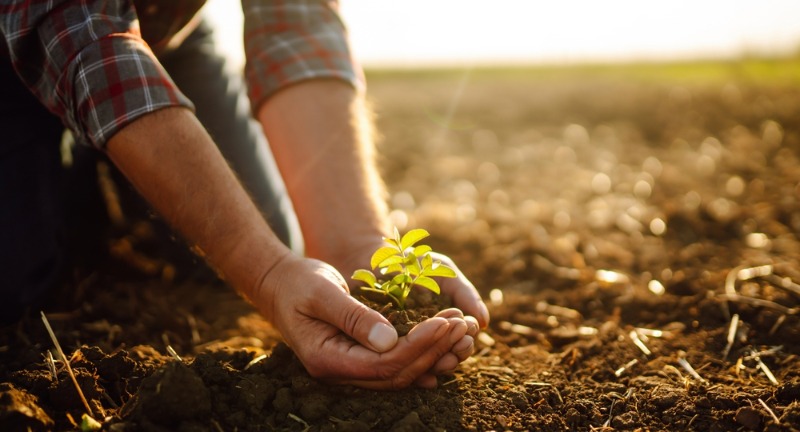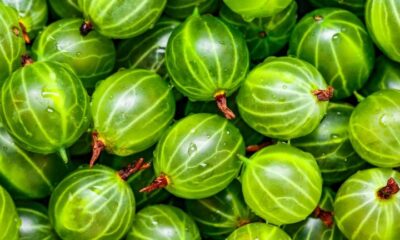EXPLORE
33 of the Most Important Tips for Beginner Gardeners
Published
1 month agoon

Shutterstock
Gardening is one of those pursuits that manages to be both wildly unpredictable and deeply satisfying—kind of like putting the last piece on a 1,000 piece puzzle. One day you’re marveling at the first bloom, and the next, you’re locked in a staring contest with a weed that refuses to move. Whatever your goals, this guide has your back, because let’s face it, we could all use a little help when nature starts showing off its sense of humor.
Enjoy the Process and Don’t Stress Over Mistakes

Shutterstock
Gardening is as much about the journey as the results—mistakes are inevitable, but they’re also how you learn. Even scientists scratch their heads over why some experiments fail, so cut yourself some slack. Enjoy the sunshine, the dirt under your nails, and the small victories along the way. Your garden will grow, and so will your skills.
Start Small and Expand as You Gain Confidence

Shutterstock
Starting small isn’t just practical—it’s how you avoid having a breakdown over 50 tomato plants that decided to rebel. A modest garden is easier to manage, less overwhelming, and more forgiving of mistakes. A lot of humans think they can transform into master gardeners overnight—it’s an unsolved mystery! Stick to a small plot at first, and grow alongside your plants.
Choose Plants Suited to Your Climate and Region

Shutterstock
Plants that thrive in your local climate are like the home team—they know the conditions and perform better. Sure, you might dream of growing exotic orchids in your backyard, but unless you live in a tropical paradise, they’ll probably stage a dramatic exit. Stick to local favorites, and they’ll reward you with robust growth and fewer headaches.
Water Consistently, but Avoid Overwatering

Shutterstock
Plants are like Goldilocks—they want their water “just right.” Too little, and they’ll wilt dramatically; too much, and their roots may rot faster than you can say “oops.” Some plants are better than others at bouncing back from overwatering, but even in those cases, it’s healthier for the plant to just keep the water levels appropriate from the get-go. Pay attention to your soil’s moisture, and remember that roots love water, even if they can’t swim in it!
Use Quality Soil or Compost for Better Results

Shutterstock
Good soil is the secret sauce of gardening, and no, the store-bought stuff isn’t cheating. Plants thrive in nutrient-rich environments, and compost adds that extra touch of magic. The process where organic material breaks down into plant food is impressive, turning yesterday’s banana peel into what’s practically gardening gold.
Use Natural Pest Control Methods When Possible

Shutterstock
Why reach for chemicals when nature has already armed you with pest-fighting allies? From ladybugs to neem oil, there are countless ways to handle garden invaders without breaking out the big, toxic guns. In some cases, it’s actually better to consider the natural option first, since some bugs seem immune to synthetic solutions but run for the hills when faced with natural ones. Trust the power of Mother Nature—she’s been at this way longer than we have.
Mulch to Retain Moisture and Suppress Weeds

Shutterstock
Mulch is the unsung hero of gardening—it keeps soil cool, locks in moisture, and bullies weeds into submission. Why plants grow better under a layer of mulch remains a topic of scientific intrigue, but the results are undeniable. Choose organic mulch like wood chips or straw, and let it do the heavy lifting for your garden. It’s like a cozy blanket for your soil, but without the lint.
Space Plants Properly to Prevent Overcrowding

Shutterstock
Overcrowded plants are like roommates in a tiny apartment—someone always suffers. Give your plants room to breathe and grow, and they’ll repay you with healthier roots and better yields. Overcrowding leads to fights over sunlight, water, and nutrients, not to mention a higher risk of pests and diseases crashing the garden party.
Start with Easy-to-Grow Plants Like Herbs or Lettuce

Shutterstock
If you’re new to gardening, start with plants that practically grow themselves. Herbs and lettuce are forgiving, fast-growing, and rewarding—even if you’re prone to over-enthusiastic watering (we’ve all been there). Plant these, and you’ll have fresh greens and herbs to show off in no time.
Rotate Crops Annually to Avoid Soil Depletion

Shutterstock
Crop rotation isn’t just for farmers—it’s essential for keeping your garden’s soil healthy. Planting the same thing year after year can drain the soil of nutrients, leaving it exhausted. Rotate your crops, and your healthy soil will help your plants stay happy and productive.
Keep a Gardening Journal to Track Progress

Shutterstock
A gardening journal might sound old-school, but it’s the ultimate tool for learning from your mistakes and celebrating your wins. Record what you planted, when you planted it, and how it’s doing—because trust me, you won’t remember whether it was last Tuesday or two months ago that you watered the zucchini. Sure, some gardeners thrive without notes, but others need detailed records to thrive, and there’s no way of telling which you’ll be until you try! Plus, it’s fun to look back and see how far you’ve come (or how much you’ve learned).
Remove Weeds Regularly to Prevent Competition

Shutterstock
Weeds are the ultimate garden freeloaders, stealing nutrients and sunlight from your plants. Regular weeding keeps them in check and gives your garden a chance to thrive. Scientists have studied weeds for ages but can’t fully explain their uncanny ability to outcompete cultivated plants. Pull them out before they take over—it’s therapeutic and wildly satisfying.
Learn the Signs of Pests and Diseases

Shutterstock
Brown spots, chewed leaves, or a trail of mysterious holes—your plants might be screaming for help. Identifying pests and diseases early can save your garden from disaster, so it’s worth the trouble. Remember, it just takes a few inattentive days for insects and other pests to make quick work of your garden! Stay vigilant, and remember that a gardeners best tool isn’t a shovel, it’s their keen eye.
Don’t Plant Too Early—Wait for the Last Frost

Shutterstock
Impatience is a gardener’s worst enemy—plant too early, and you’re inviting frost to crash your garden party. Waiting for the last frost date might test your patience, but your plants will thank you for it. In an ironic twist, frost tends to damage tender seedlings while still leaving the weeds unharmed (seriously, why?), so unless you’re planning to exclusively plant weeds, it might be best to hold off until the weather warms up.
Grow Companion Plants for Mutual Benefits

Shutterstock
Companion planting almost feels like magic, because it makes the entire garden better than just the sum of its parts. Some plants repel pests, while others improve soil or shade their buddies, creating a harmonious mini-ecosystem. Some plants are just natural besties—like tomatoes and basil, which not only grow well together but also end up on a pizza. Talk about a win-win!
Use Raised Beds for Better Drainage

Shutterstock
Raised beds are like VIP sections for your plants—they get better drainage, a warmer start in the spring, and fewer unwelcome guests like weeds and pests. Plus, they’re easier on your back, which means less crouching and more admiring your handiwork from a dignified distance. Your plants will thrive, and you’ll look like a gardening genius—win-win!
Avoid Planting All Seeds at Once; Stagger for a Longer Harvest

Shutterstock
Planting all your seeds at once might feel productive, but it’s a rookie mistake that makes up the difference between feast-or-famine harvests. Stagger your planting schedule, and you’ll enjoy a more gradual, yet consistent supply of fresh produce instead of a one-time bounty. This way, you’ll enjoy a steady stream of harvests rather than a one-time explosion of produce that leaves you wondering how to store 20 pounds of lettuce. Spread things out, and your future self will thank you for it.
Know Your Hardiness Zone

Shutterstock
Your hardiness zone is the gardening equivalent of knowing your address—it tells you what plants can handle your local climate. Planting something outside your zone is a gamble that rarely pays off. It’s best to stick to your zone for reliable results, and save the daring experiments for another time. Understanding your hardiness zone helps you pick plants that won’t just survive but will thrive, saving you from the heartbreak of watching a tropical beauty wither in a surprise cold snap.
Fertilize Sparingly but Effectively

Shutterstock
Fertilizer is like vitamins for your plants—too little, and they struggle; too much, and they end up overfed and cranky. Use it sparingly, targeting the nutrients your soil actually needs (yes, there’s a science to it, but thankfully, test kits exist). Still, it’s all too often that plants respond to fertilizer like kids on a sugar rush, so remembering that balance is key is the ticket. Feed your garden wisely, and you’ll reap lush, healthy growth without any tantrums.
Label Your Plants to Stay Organized

Shutterstock
Labeling your plants might feel unnecessary—until you forget what you planted and end up mistaking carrots for weeds. Clear labels keep you organized and save you from future confusion. A quick label now saves a lot of head-scratching later, and besides, nothing’s more embarrassing than that awkward moment of realizing you’ve been lovingly watering a patch of weeds for weeks.
Don’t Be Afraid to Experiment with New Plants

Shutterstock
Gardening is as much about trying new things as it is about growing the classics. Experimenting with unfamiliar plants might lead to surprising successes—or at least some entertaining stories. Push your boundaries, and who knows? You might discover your new favorite plant. Remember, even if you end up with a mutant tomato, at least you’ll have a great story for the next dinner party!
Protect Plants from Extreme Weather with Covers or Shelters

Shutterstock
Mother Nature can be unpredictable, but covers and shelters can give your plants a fighting chance. Frost, wind, and scorching heat are no match for a well-placed tarp or cloche. Protect your garden, and it’ll weather the storms in style. Just remember, if you don’t put up that white tarp today, you might find your plant waving a white flag tomorrow!
Stay Consistent with Garden Maintenance

Shutterstock
Consistency is the secret sauce to a thriving garden—plants don’t thrive on neglect. Regular weeding, watering, and care keep your garden looking its best, even if science can’t explain why weeds grow faster than anything else. Set a routine, and your plants will reward you with lush growth and blooms. A little effort each day beats a marathon of catch-up work any time.
Learn Your Soil Type and Amend It if Needed

Shutterstock
Clay, sandy, loamy—your soil type determines how your garden grows. Soil textures affect water retention and root growth, so if you want the perfect garden, you’ll have to start from the ground-up (literally)! Amend your soil with compost, sand, or whatever it needs to thrive, and your plants will reward your efforts.
Deadhead Flowers to Encourage More Blooms

Shutterstock
Deadheading is less morbid than it sounds—removing spent blooms signals your plants to keep producing flowers instead of focusing on seeds. It’s like the gardening equivalent of hitting the refresh button, only with petals. Plus, keeping those flowers neat and tidy just gives your garden a more polished, “I totally know what I’m doing” vibe, even if you just fake it ’till you make it!
Learn the Growth Habits of Each Plant

Shutterstock
Bush, vine, or ground cover—understanding how your plants grow is key to giving them what they need. Some plants like to sprawl, while others prefer to climb, and scientists still scratch their heads at how vines instinctively find something to grab onto. Supporting your plants’ natural habits keeps them healthy and prevents chaos in your garden beds. Know and account for their quirks, and your garden will thank you for the thoughtful accommodations.
Keep Tools Clean and Sharp for Better Efficiency

Shutterstock
A sharp, clean tool is a gardener’s best friend—cuts are smoother, plants heal faster, and your workload feels lighter. Dirty, dull tools can spread disease and cause more harm than help! Why we’re all so tempted to skip cleaning is a constant mystery, but trust us, it’s worth the effort. It’s always best to treat your tools like an extension of yourself, so don’t forget to wash your hands (or shovel)!
Prune Plants to Promote Healthy Growth

Shutterstock
Pruning isn’t just a haircut for your plants; it’s their ticket to a healthier, happier life. Snipping off dead or overcrowded branches improves airflow and encourages growth, even if it feels like tough love. The science behind pruning is simple—plants use energy more efficiently without extra baggage. Grab your shears, channel your inner stylist, and watch your garden strut its stuff.
Harvest at the Right Time for Best Flavor and Yield

Shutterstock
Timing is everything when it comes to harvesting—pick too early, and you’ll miss out on flavor; too late, and your plants might stop producing. Harvesting at the right time means catching your veggies at their peak flavor, not when they’re overdue for the compost bin. Check your crops daily, and enjoy the satisfaction of a perfectly timed harvest. Your taste buds will thank you.
Pay Attention to Sunlight Requirements

Shutterstock
Not all plants are sun worshippers—some prefer shady hideouts, and others thrive with just a few hours of morning light. Photosynthesis is powerful, but apparently, plants have preferences too! Observe your garden to understand where the sunlight hits, because putting a shade-lover in full sun is like handing it a sunscreen bottle and hoping for the best. Match your plants with the right light, and they’ll do most of the work for you.
Learn to Compost and Recycle Garden Waste

Shutterstock
Composting is like alchemy for your garden—turn kitchen scraps and yard waste into nutrient-rich gold. Microorganisms do the heavy lifting, breaking it all down, though science still marvels at their efficiency. Starting a compost pile is easy and makes you feel like an eco-warrior, even if it’s just banana peels and coffee grounds. Reduce waste, enrich your soil, and join the circle of life—it’s a win-win-win.
Observe Your Garden Daily to Catch Issues Early

Shutterstock
A daily walk through your garden isn’t just peaceful—it’s proactive. Early detection of pests, diseases, or nutrient deficiencies can save your plants from what would’ve otherwise been a disaster! Observing regularly keeps you connected and helps you anticipate problems before they escalate. Plus, you might spot a new bloom or two—it’s like a reward for being attentive.
Share Tips and Ideas with Other Gardeners

Shutterstock
Gardening isn’t a solo sport—sharing tips and swapping advice with others can transform your experience. Fellow gardeners might have tricks up their sleeves that science hasn’t officially endorsed but work like magic nonetheless. Whether it’s a neighbor or an online community, connecting with others brings inspiration and camaraderie. Plus, it’s a great way to show off your prized plant without seeming too smug.
Conclusion

Shutterstock
So here we are at the end of our little gardening adventure, but your story is just getting started. Whether your garden ends up being a riot of blooms or a noble experiment in “Well, at least I tried,” you’re officially part of the club now. The truth is, no one has all the answers—But that’s the magic, isn’t it? So go out there, embrace the dirt under your nails, and remember: every gardener gets a second chance next season.
Related Topics:

More From Lifestylogy
-


25 Fruits That Have A Sour Reputation And Taste
-


22 State Laws That Are Hard To Believe They Actually…
-


24 Uses For Bananas That Are Oddly Practical
-


Rare Photos From History That You Probably Haven’t Seen Before
-


Vintage Photos of Hollywood Icons Unlike You’ve Ever Seen Before
-


25 Things Only Servers Understand
-


25 Tips For Attending A Golf Tournament Like The PGA…
-


Relatable Wedding Moments We Know Too Well
-


27 Books That Everyone Should Read At Least Once In…